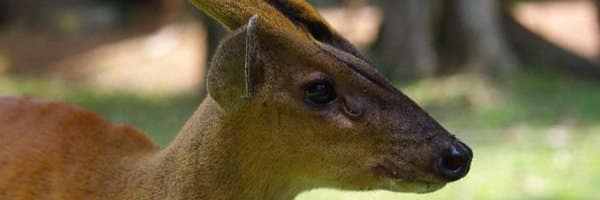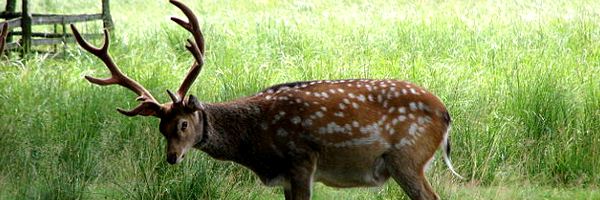Pampas Deer – Ozotoceros bezoarticus
The light tan coloring of the Pampas Deer allows it to perfectly blend into the surroundings. They have patches of white around the eyes, lips and along the throat area. They also feature a tail that is short and bushy. The fact that they also have a white patch under the tail is why they are often confused with the White Tailed Deer species.
The males weigh about 90 pounds and the females about 10 pounds lighter than that. The antlers for the males are small and very light in weight. They tend to develop a three prong design to them. The females develop tiny stubs but not antlers.
Pampas Deer Distribution
You will find the Pampas Deer living at the lower elevations of South America. They tend to stick to the open plains as rugged terrain is very difficult for them due to the development of their hooves. They can be found in the grassland areas with grass that is tall enough to completely hide them from predators. The Pantanal Wetlands is also home to them. Of the 80,000 or so Pampas Deer that still live in the wild, almost all of them are found in Brazil.
Pampas Deer Behavior
The males are very territorial which is why they give off a strong odor as they walk. The glands are located on their legs. The smell that the Pampas Deer offers can be pickup up 1 mile away so it is well known that they have claimed a territory in a given location.
The females are able to wonder in and out of the territory of the males without any problems. They often form large herds as long as there is enough food for all to survive in a given area. The males of this deer species are more likely to interact with the females for purposes other than mating than other species are.
Pampas Deer Feeding
The diet for this particular deer includes grass, leaves, shrubs, and various herbs that grown in their habitat. In many areas they are competing with cattle for the same available food sources. The Pampas Deer is often seen standing up on its hind legs in order to reach food sources that are taller than it happens to be.
Pampas Deer Reproduction
The males often don’t have to fight each other to be able to mate with females. They will scrap their antlers on the ground though and try to show dominance. Usually one of the males will walk away before the situation has to go any further than that.
The courting rituals for mating with the Pampas Deer are very interesting. The male will make a gesture such as stretching to see if the female is responsive or not. Nuzzling by the pair around the neck areas is a sign that they do want to mate with each other.
They live about 12 years in the wild but are known to live up to 20 years while in captivity.
Pampas Deer Conservation
Conservation efforts around the Pantanal Wetlands are in place for the Pampas Deer. The goal is to help ensure that they are able to keep that natural habitat. Too much of it has already been taken over by humans for their own use. The combination of habitat loss with hunting has created a huge dip in their overall numbers.
Pampas Deer Human interaction
When humans move into the areas where the Pampas Deer have called home for a very long time they should expect some problems. These deer have been labeled troublesome due to the fact that they will get into crops and other food sources that humans are trying to grow in such locations.







